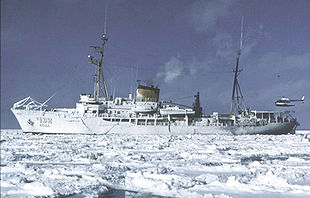NOAAS Surveyor (S 132)
 Surveyor conducting helicopter operations in the Bering Sea | |
| Career (United States) | |
|---|---|
| Name: | Surveyor |
| Namesake: | A surveyor is a member of the profession of surveying, which determines positions on the earth's surface |
| Builder: | National Steel and Shipbuilding Company, San Diego, California |
| Launched: | 25 April 1959 |
| Commissioned: | 30 April 1960 |
| Decommissioned: | 1995 or 1996[1] |
| Nickname: | "Old Workhorse" |
| Notes: |
Served in U.S. Coast and Geodetic Survey 1960-1970 Served in National Oceanic and Atmospheric Administration from 1970 until 1995 or 1996[2] |
| General characteristics | |
| Type: | Oceanographic survey ship |
| Tonnage: |
2,653 gross tons 682 net register tons |
| Displacement: | 3,440 tons (full load) |
| Length: | 292 ft 2 in (89.05 m) |
| Beam: | 46 ft (14 m) |
| Draft: | 19 ft 5 in (5.92 m) |
| Installed power: | 3,200 shaft horsepower (2.4 megawatts) |
| Propulsion: | Two sets Laval geared steam turbines, two Combustion Engineering boilers, one shaft, 785 tons fuel |
| Speed: | 15 knots (sustained) |
| Range: | 13,680 nautical miles (25,335 kilometers) |
| Endurance: | 38 days |
| Boats and landing craft carried: |
3 x 36-foot (11-meter) wooden survey launches 1 x ex-U.S. Navy LCVP 2 x 26-foot (7.9-meter) motor whaleboats |
| Complement: | 92 (12 NOAA Corps officers, 6 civilian officers, 58 crew members, 16 scientists) |
| Aviation facilities: | Helicopter pad |
| Notes: |
800 kilowatts electrical power Last steam-powered Coast and Geodetic Survey ship First Coast and Geodetic Survey ship with a deep-water multi-beam echosounder |
USC&GS Surveyor, later NOAA Ship Surveyor (S 132), was an oceanographic survey ship that served in the United States Coast and Geodetic Survey from 1960 to 1970 and in the National Oceanic and Atmospheric Administration (NOAA) from 1970 until 1995 or 1996.[3] She was the second and last Coast and Geodetic ship named Surveyor and has been the only NOAA ship thus far to bear the name.
Contents
Construction and characteristics
Surveyor was built by National Steel and Shipbuilding Company in San Diego, California, and launched on April 25, 1959. She was the last steam-powered ship built for the Coast and Geodetic Survey, and the first to be equipped with a deep-water multi-beam echosounder. Her construction marked the beginning of a major effort to modernize the Coast and Geodetic Survey fleet and make it capable of conducting operations worldwide.
In addition to the deep-water echosounder, Surveyor had a shallow-water echosounder, a stabilized mapping sonar system, a Hydroplot data-processing system, a data-processing computer, seismic reflection profile processors, seismic reflection profile processors, and an extensive suite of navigation equipment, as well as a wet and dry oceanography laboratory, a gravimetric laboratory, and a photographic laboratory.
Operational Career
Surveyor was commissioned into service with the Coast and Geodetic Survey on April 30, 1960. When NOAA was created in 1970 and took over the Coast and Geodetic Survey's assets, she became a part of the NOAA fleet, designated S 132, for the rest of her career.
Based at Seattle, Washington, and known as "Old Workhouse," Surveyor spent her career in the Pacific Ocean and Arctic Ocean, operating as far north as the Beaufort Sea off Alaska and as far south as the Palmer Peninsula in Antarctica; she conducted hydrographic surveys in such widely separated areas as Norton Sound in Alaska and American Samoa. She was the primary ship for studying the Alaskan Arctic for the Outer Continental Shelf Environmental Assessment Program (OCSEAP) and for studying Antarctic Marine Living Resources (AMLR.) She also conducted multi-beam echosounder surveys along the United States West Coast, off the southern coast of Alaska, throughout the Juan de Fuca Ridge area off the coast of Washington and British Columbia, and in Hawaiian waters. She discovered Axial Seamount on Endeavor Ridge, a seamount that apparently has been split in half by seafloor spreading.
On March 6, 1980, while Suveyor was tied to a pier in San Francisco, California, one of her crewmen fell over the side into the water between the ship and the pier. Without hesitation another crewman, Able-Bodied Seaman Wallace K. Kanahele, leaped into the water, rescued the man -- who was suffering from hypothermia -- and brought him to a small boat which had been lowered by another vessel. For saving his shipmate's life, Kanahele received the 1980 Department of Commerce Gold Medal.
Surveyor was retired from service in either 1995 or 1996.[4]
Commemoration
The Surveyor Fracture Zone, Surveyor Gap, and Surveyor Seachannel all are named for Surveyor.
Notes
- ↑ The NOAA History entry for the ship at http://www.history.noaa.gov/ships/surveyor2.html provides both dates without further explanation
- ↑ The NOAA History entry for the ship at http://www.history.noaa.gov/ships/surveyor2.html provides both dates without further explanation
- ↑ The NOAA History entry for the ship at http://www.history.noaa.gov/ships/surveyor2.html provides both dates without further explanation
- ↑ The NOAA History entry for the ship at http://www.history.noaa.gov/ships/surveyor2.html provides both dates without further explanation
References
- NOAA History, A Science Odyssey: Tools of the Trade: Ships: Coast and Geodetic Survey Ships: Surveyor
- NOAA History, A Science Odyssey: Hall of Honor: Commerce Medals Presented for Lifesaving and the Protection of Property 1955-2000
- Prézelin, Bernard, and A. D. Baker III, eds. The Naval Institute Guide to Combat Fleets of the World 1990/1991: Their Ships, Aircraft, and Armament. Annapolis, Maryland: United States Naval Institute, 1990. ISBN 0 87021 250 8.
